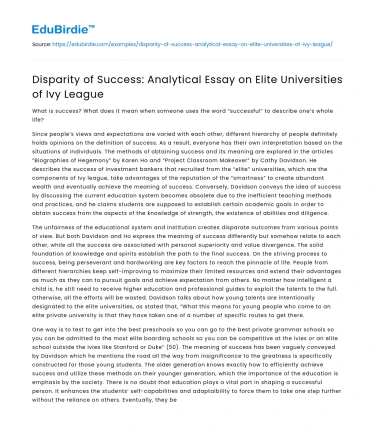Introduction
The Ivy League represents a consortium of eight private higher education institutions in the United States, widely lauded for their academic excellence, social prestige, and historical significance. While these universities, including Harvard, Yale, and Princeton, boast illustrious alumni and a reputation for fostering success, a significant disparity exists in the success achieved by their graduates. This disparity can be attributed to various factors, including socioeconomic background, access to resources, and institutional biases. Academic success and career progression for Ivy League graduates are not uniformly guaranteed, with some students experiencing substantial advantages over others. This essay aims to unravel the paradox of success within the Ivy League, examining the contributing elements and addressing the counter-arguments to provide a comprehensive understanding of this complex issue.
Socioeconomic Influences on Success
One of the most significant factors contributing to the disparity of success among Ivy League graduates is socioeconomic background. Students from affluent families often have access to superior preparatory education, extensive networks, and financial resources, which can enhance their university experience and post-graduate opportunities. According to a study by Chetty et al. (2017), students from the top 1% of income distribution are significantly more likely to attend elite universities compared to those from lower-income backgrounds. This economic advantage extends beyond mere admission, influencing access to internships, career advice, and exclusive networking events.
Save your time!
We can take care of your essay
- Proper editing and formatting
- Free revision, title page, and bibliography
- Flexible prices and money-back guarantee
Conversely, students from lower socioeconomic backgrounds may face financial constraints that limit their ability to fully engage in the college experience. While many Ivy League institutions offer substantial financial aid packages, these often do not cover the entire cost of attending, particularly when considering hidden expenses such as travel, textbooks, and extracurricular activities. The psychological burden of financial insecurity can also detract from academic focus and social integration, further exacerbating the divide in post-graduate success.
It is crucial to consider counter-arguments suggesting that Ivy League schools provide ample support to level the playing field for students from diverse backgrounds. Programs aimed at fostering inclusivity and diversity, such as mentorship initiatives and need-based scholarships, are frequently highlighted as evidence of institutional commitment to equality. However, despite these measures, the outcomes remain uneven, as systemic inequalities persist beyond the confines of university campuses, impacting long-term career trajectories.
Access to Resources and Opportunities
The availability of resources and opportunities within Ivy League institutions significantly influences graduate success, yet access to these advantages is not uniformly distributed among the student body. Elite universities offer an array of academic and extracurricular resources, including state-of-the-art facilities, eminent faculty, and a wealth of research opportunities. However, the ability to capitalize on these resources often depends on a student's prior exposure and ability to navigate complex institutional structures.
Students who enter with a robust educational foundation and familiarity with elite academic environments are typically better equipped to leverage available opportunities. In contrast, first-generation college students or those from underrepresented backgrounds may lack the necessary guidance or confidence to fully engage with these resources. According to a report by the Jack Kent Cooke Foundation (2016), students from disadvantaged backgrounds often face barriers in accessing high-impact practices such as study abroad programs, internships, and research positions, which are pivotal in enhancing career prospects.
While some may argue that Ivy League institutions actively promote equal access to resources through targeted programs and initiatives, the effectiveness of these efforts is often limited by broader systemic issues. For instance, implicit biases within selection processes for prestigious internships or fellowships can disadvantage minority students, perpetuating the cycle of inequality. Thus, while opportunities abound, the unequal distribution of access results in disparate outcomes among graduates.
Institutional Bias and Cultural Capital
Institutional biases and the concept of cultural capital further contribute to the disparity of success observed among Ivy League graduates. Cultural capital, as defined by Bourdieu, encompasses the non-financial social assets that promote social mobility, such as education, intellect, style of speech, and appearance. Within the context of elite universities, cultural capital plays a pivotal role in determining a student's ability to assimilate into the institutional culture and succeed.
Students from privileged backgrounds often possess the cultural capital that aligns with the expectations and norms of Ivy League institutions. This alignment facilitates smoother transitions and integration into the academic and social fabric of the university, enhancing their overall experience and success. In contrast, students lacking this cultural alignment may struggle to adapt, face social alienation, or encounter biases that hinder their academic and professional progression.
Counter-arguments suggest that Ivy League schools are actively working to dismantle institutional biases and promote diversity through inclusive policies and practices. Initiatives such as cultural competency training, diverse hiring practices, and support networks for minority students are steps toward addressing these issues. However, despite these efforts, the deep-seated nature of institutional biases means that change is often slow and incremental, leaving significant disparities in place.
Conclusion
In conclusion, while the Ivy League institutions are synonymous with success and prestige, the reality of graduate outcomes reveals a complex web of disparities influenced by socioeconomic factors, access to resources, and institutional biases. Despite efforts to promote equality and inclusivity, these challenges persist, underscoring the need for continued examination and reform. Addressing these disparities requires a multifaceted approach, involving not only changes within the institutions themselves but also broader societal shifts to dismantle systemic inequalities. As the dialogue around equity in education continues to evolve, it is imperative for Ivy League schools to lead by example, ensuring that the promise of success they offer is accessible to all, regardless of background.






 Stuck on your essay?
Stuck on your essay?

